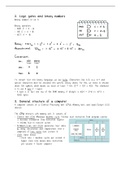Notes de cours
TB142ib (I&C) - Computer & Information Systems
- Cours
- Établissement
- Book
Notes from all lectures about binary numbers, operating systems, object-oriented programming (OOP), data types and algorithms (insertion sort, bubble sort, sequential search, binary search). Important concepts are marked in bold, other terms are underlined.
[Montrer plus]







